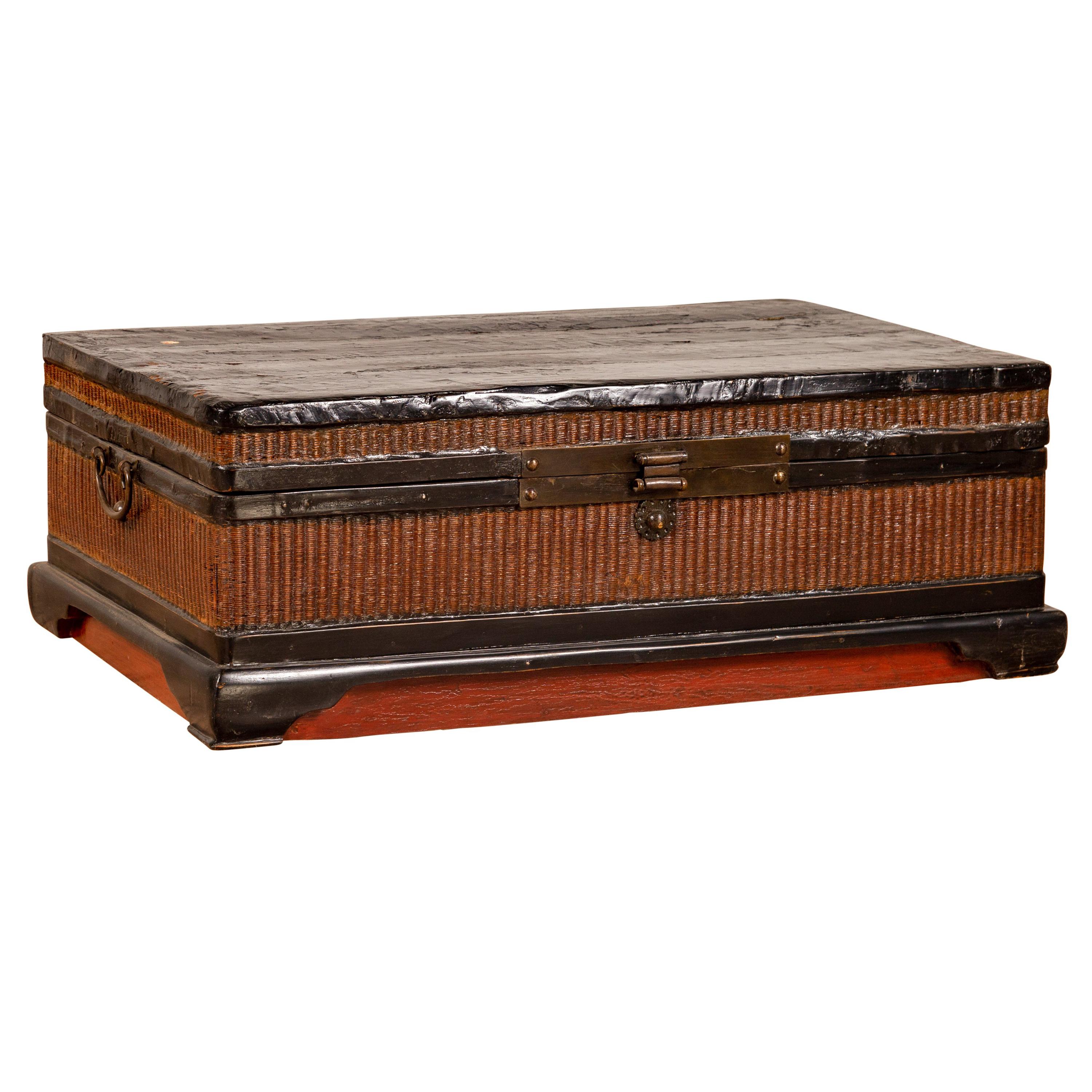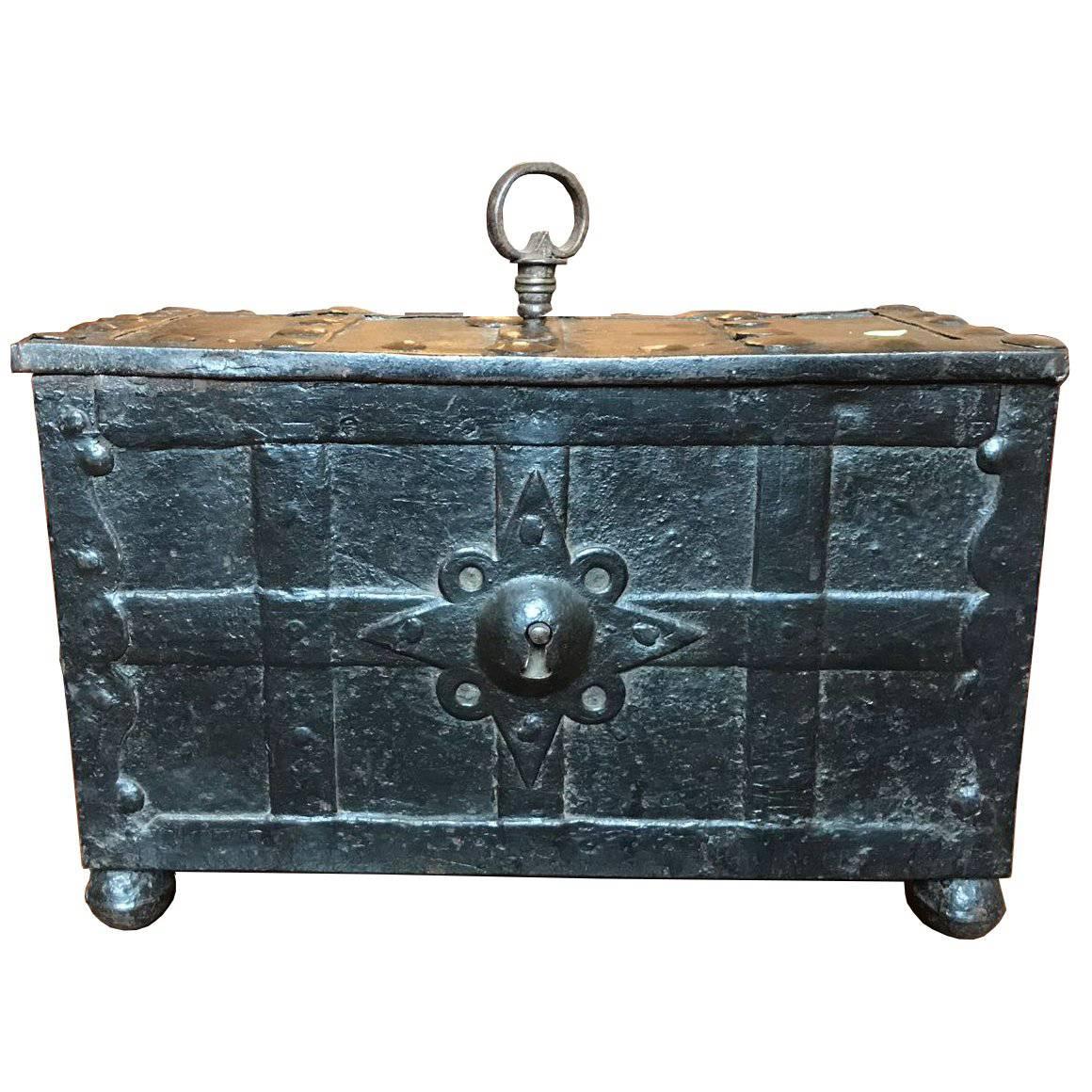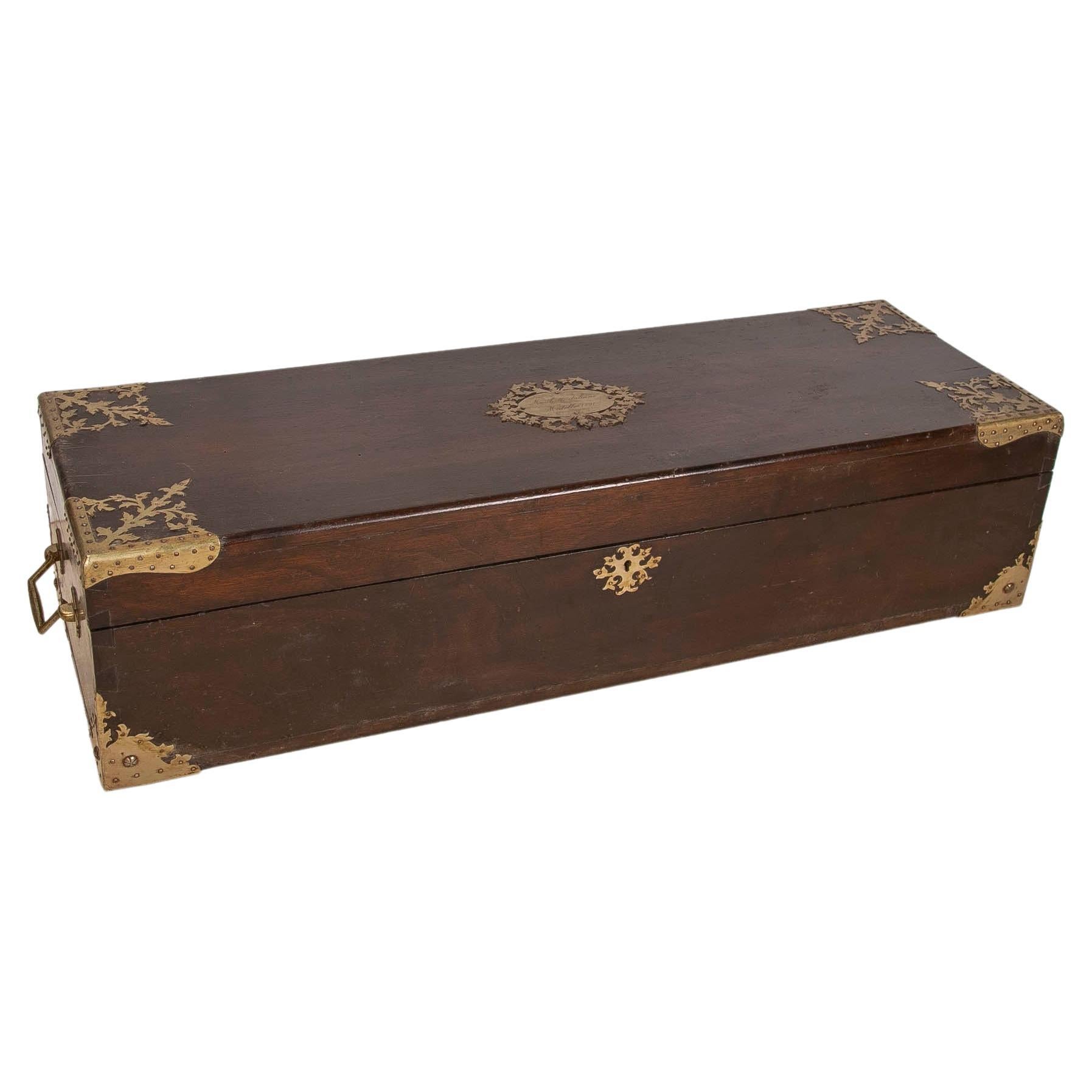Items Similar to Circa 1650 Sheet Iron Money Chest from Southern Germany with Wooden Stand
Want more images or videos?
Request additional images or videos from the seller
1 of 21
Circa 1650 Sheet Iron Money Chest from Southern Germany with Wooden Stand
About the Item
In 15th and 16th century Europe, the works of blacksmiths from southern Germany were known far and wide. Demand for products by these skilled metal workers spread as far as the Scandinavian countries. Perhaps one of the most intriguing items that was produced by these workshops was the iron money chest. These chests usually featured complicated locking mechanisms (visible on the underside of the lid) with a false keyplate on the front facade to deter would-be thieves. In the 17th century, many craftsmen began to cover the internal workings with a painted cover, just like the pierced red painted plate on our chest.
The faux lock on the front facing is surrounded by a large sinuous, open motif that is flanked by two latches that fit over eyelets attached to the lid. On the outside of each latch is a figure eight element, possibly an ouroboros, which is a snake eating its own tail. There are two more of these figures on each side, next to a large handle. All sides have a simple latticework pattern where the intersections are secured by large nailheads. The actual lock is found in the center of the lid, amongst the latticework and a foliate-like keyplate.
Our chest from southern Germany was produced circa 1650. At some point, a previous owner had a wooden stand crafted for displaying purposes. The stand itself is over 100 years old and has been painted black more recently. There is an internal arm that can be raised to keep the lid open, making it possible for the interior of this fascinating chest to be displayed. The original key is included and operates the locking mechanism.
- Dimensions:Height: 29 in (73.66 cm)Width: 28.5 in (72.39 cm)Depth: 19 in (48.26 cm)
- Style:Baroque (Of the Period)
- Materials and Techniques:
- Place of Origin:
- Period:Mid-17th Century
- Date of Manufacture:circa 1650
- Condition:Additions or alterations made to the original: A previous owner had the black stand built for displaying. Refinished. Wear consistent with age and use. Good antique condition. Wear commensurate to age and use. Light oxidation. Chest has been repainted. Minor losses are present, especially inside. Wood stand is not original, but antique, painted with high sheen black paint. Traces of old wood worm.
- Seller Location:Dallas, TX
- Reference Number:
About the Seller
5.0
Platinum Seller
These expertly vetted sellers are 1stDibs' most experienced sellers and are rated highest by our customers.
Established in 1983
1stDibs seller since 2011
738 sales on 1stDibs
Typical response time: <1 hour
- ShippingRetrieving quote...Ships From: Dallas, TX
- Return PolicyA return for this item may be initiated within 2 days of delivery.
More From This SellerView All
- Spectacular Painted Six-Panel Armorial Baroque Screen from Italy, Circa 1700Located in Dallas, TXThis six panel Italian screen is from the Baroque period, circa 1700. The four central panels have been affixed to a foldable frame, while the two outer panels are detached. When all...Category
Antique Early 18th Century Italian Baroque Screens and Room Dividers
MaterialsCanvas, Wood
- Antique Wool and Silk Tapestry from Brussels, Circa 1650Located in Dallas, TXHand-woven in Brussels, circa 1650, this wool and silk tapestry depicts a church scene with six clergymen at an altar. After roughly 375 years, the colors are still vibrant, highlighted by fabrics of blue that punctuate the predominately gold, cream, and brown fibers of the textile. Two young bishops, possibly receiving their consecration, kneel on the steps of the altar, dressed in a cassock beneath a chimere, with one holding a thurible and the other a biretta. A third bishop stands in front of them, as two elder clergymen look on from the right of the altar. The older of the two holds a crozier and a biretta with arms extended from beneath a luxurious blue and gold ferraiolo. On the opposite side of the altar is the sixth and final bishop, who is wearing his biretta and holding a mitre. The luxurious altar is adorned with tall gilt candlesticks...Category
Antique Mid-17th Century Belgian Baroque Tapestries
MaterialsTextile, Wool, Silk
- Long circa 1800 Gothic Style Oak Board Trunk from FranceLocated in Dallas, TXThis is an unusually long Gothic style trunk from France, measuring nearly 6.5 feet long. It is carved from thick oak planks, and it dates to circa 1800. The trunk has well carved characteristic Gothic ornamentation on all of the front panels, while the rest of the piece remains simple, except a small molding to the lid. The big oak panels are joined by dowel reinforced mortise and tenon construction. The long single plank lid is attached by iron hinges and opens to reveal a large rectangular space which reveals how all the boards were assembled. There is also a latch and keyhole at the center. This rare trunk would be perfect at the foot of a king size bed, an accent piece under a tall tapestry...Category
Antique Early 19th Century French Gothic Blanket Chests
MaterialsOak
- 18th Century Iron Bound Domed Oak TrunkLocated in Dallas, TXThis handsome Baroque style oak trunk has a domed top and whimsical patinated iron mounts. The trunk was crafted in the 1700’s (possibly 1757). These types of domed oak trunks with d...Category
Antique 18th Century European Baroque Blanket Chests
MaterialsIron
- Unusual Carved Walnut Wood Inkwell from France, Circa 1880Located in Dallas, TXHand-carved from walnut in France, circa 1880, this unusual inkwell features foliate and floral motifs. A flip-top lid adorned with a pair of bas relief flowers tops the central pen ...Category
Antique 1880s French Inkwells
MaterialsWalnut
- Period Louis XIV Oak and Iron Domed Trunk, Northeast France, Circa 1700Located in Dallas, TXA fantastic example of a period Louis XIV trunk, the oak body, which features a domed top, is bound with ornate iron strapwork. The trunk originated in northeast France and was hand-...Category
Antique Early 1700s French Louis XIV Trunks and Luggage
MaterialsMetal, Iron
You May Also Like
- English Oak Campaign Chest on Stand. Circa 1820Located in Hollywood, SCEnglish Oak campaign chest on stand with hinged top, original brass mounts and side handles, baise lined interior, and resting on stand with br...Category
Antique 19th Century British Boxes
- Chinese 1900s Wooden Treasure Chest with Rattan Accents and Dark Brass HardwareLocated in Yonkers, NYA Chinese antique wooden treasure chest from the early 20th century with rattan accents and dark brass handles. This charming Chinese woo...Category
Early 20th Century Chinese Decorative Boxes
MaterialsBrass
- Vintage Deed Box, English, Art Deco, Iron, Document, Deposit, Chest, circa 1930Located in Hele, Devon, GBThis is a vintage deed box. An English, Art Deco iron document or deposit chest, dating to the early 20th century, circa 1930. Displays a desirable age...Category
Early 20th Century English Art Deco Trunks and Luggage
MaterialsBronze, Iron
- Early 17th Century Medieval Handcrafted Black Iron German CofferLocated in Brescia, ITThe iron coffer, fully original in every part of it, was forged and handcrafted in German in the 1610. Complete with key. Full working iron mechanisms. It ...Category
Antique Early 17th Century German Medieval Decorative Boxes
MaterialsIron
- Antique Hand Carved Black Forest Wooden Chest or Trunk Shape Jewelry / Cigar BoxLocated in Lisse, NLExcellent workmanship and very cool looking antique box. This 19th century and all handcrafted box is perfect for decorating the interior of your lodge, but also in a home environme...Category
Antique 19th Century German Black Forest Trunks and Luggage
MaterialsBrass
- Italian Rectangular Wooden Box with Metal Decorations and Inscription dated 1891Located in Marbella, ESItalian rectangular wooden box with metal decorations and inscription "Moschetto Italiano modello 1891".Category
Late 20th Century Italian Decorative Boxes
MaterialsWood
Recently Viewed
View AllMore Ways To Browse
Antique Furniture From Germany
Antique Plates From Germany
Wooden Surround
Wooden Display Stands
Antique Wooden Lock
Iron Lock Key
Old German Metals
Iron Display Stand
Old Antique Money
Antique Iron Works
Stand For Large Plate
Large Wooden Plate
German Lock
Southern Germany
Large Iron Key
Painted Wooden Chest
Painted Wooden Chests
Plate Display Stand





